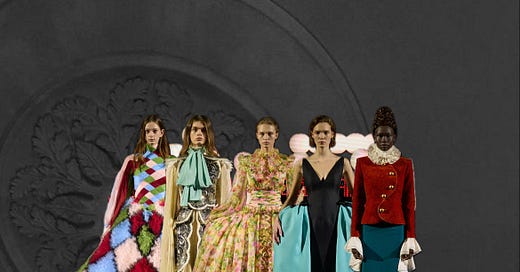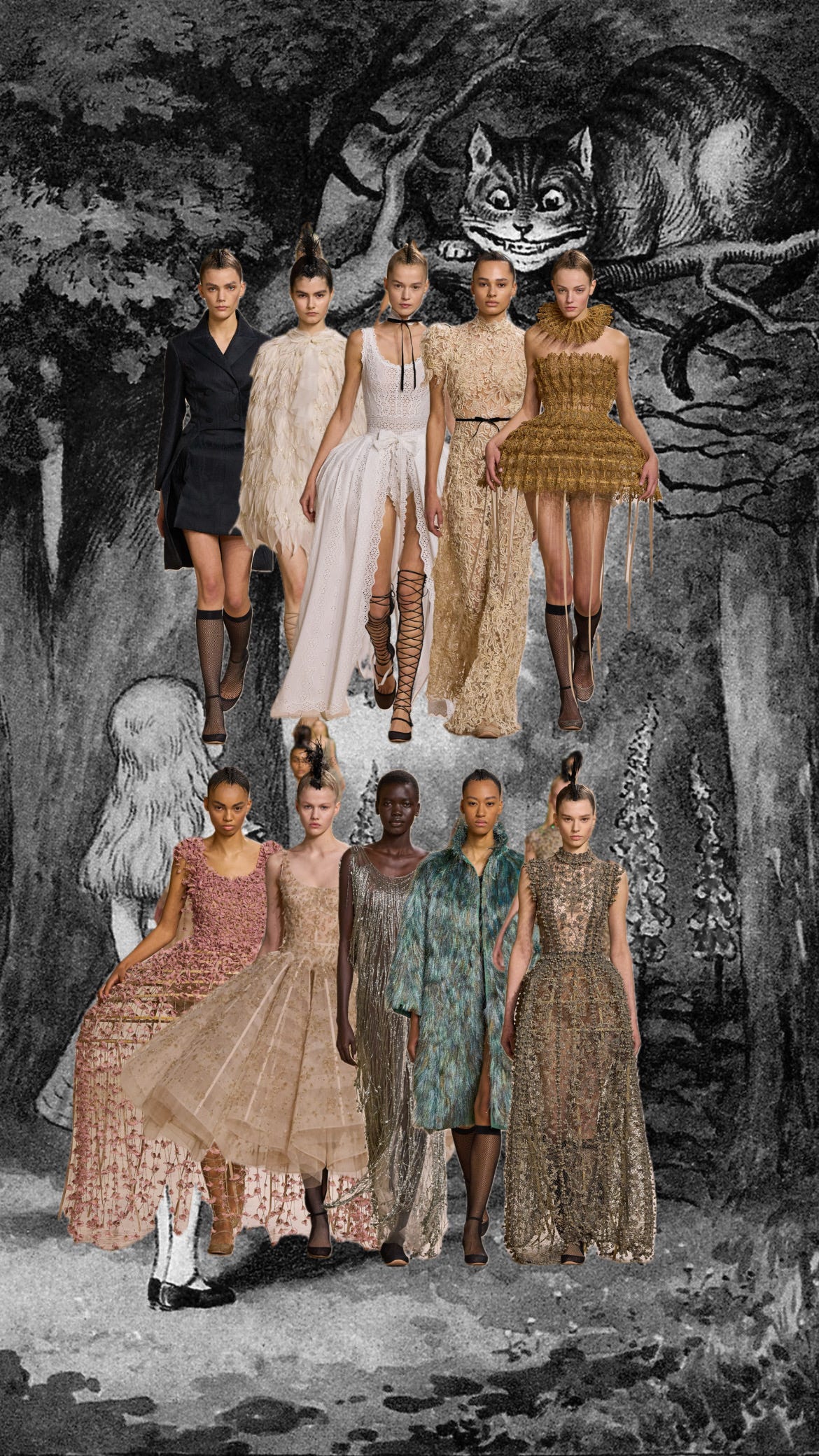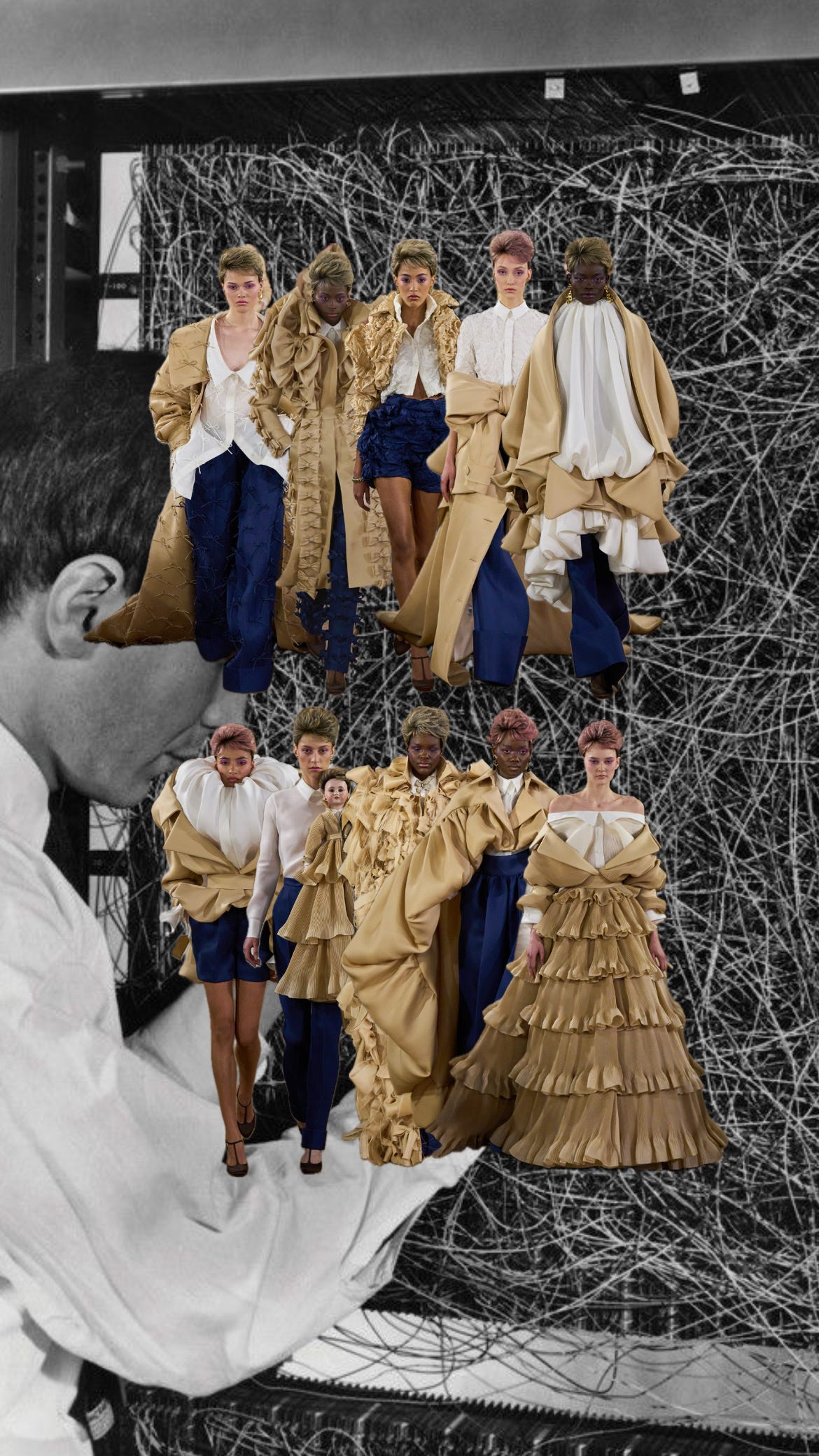Schiaparelli, Christian Dior, Valentino, Viktor & Rolf, Jean Paul Gaultier
Couture Fashion Week Spring 2025
You guys, I completely forgot to do send out a couture week newsletter. So, she’s a little late, but better late than never!!
As usual, here are my misc. thoughts before we get into the full reviews:
Rahul Mishra always goes for it and I always appreciate his exploration of our planet and beyond, even if I don’t love every look.
Alexandre Vauthier was quite paired back this season, but it was nice!
Gaimbattista Valli was very Giambattista Valli, but this season I especially enjoyed it. It as very sweet and fun, but also quite elegant.
Matthieu Blazy better hurry up and get to Chanel, because…
Alexis Mabille isn’t my personal speed, but it was very nice for what it is.
Just always have to shoutout Ronald van der Kemp’s dedication to making upcycled couture collections.
A lot of really good stuff at Armani Privé this season. Loved the printed gowns with chiffon overlay— very dreamy. Also, so much delicious embroidery.
Gaurav Gupta’s collection was all about his wife, who actually opened the show. Due to a fire, she suffered severe burns and had to undergo many surgeries, so this collection follows their journey in healing, and it was just very touching.
Miss Sohee is always so dreamy. I just imagine her gowns running through flower fields.
Schiaparelli Spring 2025 Couture
How lucky are we to live in a world where Daniel Roseberry’s Schiaparelli exists. Entitled Icarus, the show tackled the idea that couture is expected to be perfect, always outdoing itself season after season. With his Spring 2025 Couture collection for the brand, Roseberry has in fact reached a height not yet met.
While I love a kooky, surreal Schiaparelli experience, my favorite collections from the brand tend to be the ones where there is some restraint. This is not at all me calling the clothing simple, because it is far from that. It’s more so admiring the risks taken and the choices made within the couture framework– being even more creative and extravagant while still following the “rules.” After all, Roseberry said it himself, “I’m over the idea that minimalism equals modernism.”
According to the show notes, the collection was born from a trip to an antique store in which Roseberry stumbled upon ribbons from the 1920s and 30s, which were hidden away and “lost for a period to history” due to Germany’s invasion of France. Now, here some of them are, given a new life, a new hope, almost paralleling that time in history to the one we are living through now, in a world grappling with its own uncertainties.
As always, the designer credited inspiration, not imitation, to some of the couture greats, like Madame Grès, Charles Fredrick Worth, Paul Poiret, Azzeddine Alaïa, and of course, Elsa Schiaparelli herself. Using their fantasies, he created his own, while incorporating Schiaparelli house codes to “create something that feels new because it’s old.” This approach aligns with Elsa Schiaparelli’s own ethos. As a designer who drew heavily from surrealism and classical art, Schiaparelli herself often made the old feel new, translating Dali-esque dreams and Grecian drapery into wearable art. While the appeal of something new because it’s old bridges the gap between nostalgia and progress, creating designs that are deeply rooted yet forward-looking.
The plays with hard and soft, structure and fluidity, light and dark, were a feast to the eyes. It felt like all the garments were alive, charged with an energy that everyone seems to be looking for right now, but also one that is aching to be let out. Boning, pleating, and embroidery were all used to create some of the most sensual pieces that investigated proportions of the body in playful, yet alluring, ways. We might be able to trace corsetry back centuries, but here it feels almost futuristic, like something never been done before.
Spring 2025 asks us why we ever stopped embracing opulence, especially when we’re the most starved for it? Just because a collection is less conceptual, doesn’t mean it’s less compelling. Rosberry mentioned that Yves Saint Laurent once described Elsa Schiaprelli’s work as the right balance of rigor and fantasy, and I think he’d say the same about Roseberry’s. His vision, as extravagant as it is disciplined, offers a reminder of fashion’s power to inspire, provoke, and transform.
Christian Dior Spring 2025 Couture
This was one of Maria Grazia Chiuri’s better collections for Dior, although that is not at all saying much. If your expectations are already low, keep them there.
Let’s try and unpack it.
As usual, Chiuri’s list of source material was not lacking, but the collection was mainly meant to explore nonsense and be “full of joyfulness, dreams, and playfulness.” Inspiration was also drawn from Yves Saint Laurent’s A-Line collection for the brand, which Chuiri realized was based on children’s clothing– aligning perfectly with her want to channel that childlike playfulness, and the evolution of childhood into adolescence and into something a bit more punk. Artists like Leonor Fini, Dorothea Tanning, and Lewis Carroll were also on the moodboard, but like Carroll’s Alice In Wonderland would say, the collection just kept getting curiouser and curiouser…
The strengths included a silver, fringe, naked style dress, a sheer, nude dress with crinoline enforced godets, 17th century frock coats, and lace that one might think actually came from the Victorian era. There were some lovely feathered moments and pointelle pieces were done beautifully but the pieces themselves weren’t incredibly desirable. Mini crinis were quite strong, but were usually ruined by ribbons haphazardly hanging down or twisted organza that looked like it was trying to channel Nicolas Ghèsquiere’s Louis Vuttion. As for the large, cage crinoline skirts, there was something left to be desired. I am very pro crinoline, as you might know, but here they feel a little bit costume-y. This is the Christian Dior atelier after all, so embroidery and attention to detail is always done well, but here it’s wasted on messy separates or on looks that feature one design element too much. All that on the blandest color palette ever makes it difficult to believe this childlike fantasy Chiuri wanted to portray.
Perhaps through its whimsy the collection is trying to channel the surrealist chaos of the artists mentioned previously, but the semiotic message collapses under the weight of its overdetermination. There seems to be a visual dissonance that leaves the viewer questioning the collection’s emotional authenticity. Instead of presenting femininity as an ever-evolving process, the designs oscillate between clichéd representations of innocence and rebellion, never quite transcending their own limitations, and never fully embracing the radical potential of becoming.
I simultaneously feel like the collection is trying too hard to tell me what it’s about while not at all giving me enough. If we consider that a fairytale story told to you by a child often doesn’t make too much sense, then I’d say this collection channeled that perfectly.
Valentino Spring 2025 Couture
Entitled Vertigineux, the french word for “dizzying,” Alessandro Michele’s first haute couture collection for Valentino did in fact warrant a fainting couch for the overwhelming excitement and feeling one got while watching the show.
Since becoming creative director of the brand, Michele has honored the archives in ways that many probably don’t even realize. However, if you’re familiar with Valentino’s history, you’d know that the source material is very much alive and present. Yet, instead of just being an obvious recreation, the pieces are a conversation between Michele and Monsieur Valentino, making it a conversation between past and present. That, paired with his knack for finding and creating beautiful, whimsical things results in a collection that makes your heart stop. With every season so far, it feels like a treasure box lost to time has finally been opened, and all the wondrous artifacts just continue to pour out. It’s like the talking objects in Beauty and the Beast coming to life after the curse is finally broken.
We all knew Michele would know exactly how to take advantage of a couture level atelier, and as extravagant as the pieces were with their crinolines, panniers, embroidery, ruffles, colors, textures, etc. there were also a lot of smart, more wearable designs that could easily exist on their own and be adjusted to each couture client’s wants and needs. There is no denying craft and quality here, so building this world that is so romantic, yet so playful, but also mysterious, makes for a sensory overload in all the best ways possible.
In conversation with Vogue, Michele said haute couture “is a dress that doesn’t answer to real life. You can put into the dress whatever you want, with no boundaries. It’s maybe hard, because I like to have boundaries. I’m always fighting with the boundaries. I am always trying to be like water, going through the little space to destroy the things in the boundaries. Here, there is no one against me.” During a time when conservatism is on the rise, trad wife fashion is on people’s moodboards, and we are on the heels of quiet luxury discourse, a designer like Michele is so important. His unapologetic love of beauty, extravagance, and opulence at a large luxury house like Valentino, when it could be so easy to conform, matters so much when it comes to challenging that sameness we see everywhere else. It’s what has drawn me to his work from the moment he put his first furry Gucci loafer on a runway.
This refusal to conform to market-driven “wearability” aligns with Gilles Lipovetsky, who argues in The Empire of Fashion that fashion operates as both a capitalist mechanism and a site of resistance against uniformity. His designs assert the value of pure, uninhibited creativity at a time when fashion is often reduced to a status symbol rather than a form of self-expression.
He is himself, and being yourself often makes people uncomfortable, especially when it goes against the status quo. Let Michele’s Valentino remind you that we need to keep making people feel uncomfortable. In his Vogue profile he also notes, “The more free you are, the more people go crazy. I think people feel themselves to be not free. And if you are managing your freedom, they are like, ‘Why are you doing what you want, and I can’t do what I want?’ That’s interesting.”
Viktor & Rolf Spring 2025 Couture
My two faves did it again. The starting point for Viktor & Rolf this season was a quote from Karl Lagerfeld where he says, “I am like a computer, plugged into Chanel mode.” This made the duo wonder, what would happen if AI designed a collection? To be clear, no actual AI was involved in the making of this collection, it was the duo themselves acting as the AI, and the prompt was a singular one. Through the use of their own intelligence, that will always be far superior to that of the artificial, the designers themselves functioned as the algorithm to design a beige trench, white shirt, and blue pants 24 times.
Fully narrated, like during the golden age of couture, a voice generated by AI described each look the same exact way, clearly not aware of the variations in the sameness. Using 900 meters of silk gazar, a modern version of the fabric that was originally developed by Balenciaga in the 1960s, the duo used their couture level craftsmanship to reinterpret this one prompt over and over again. Whether it was a trench coat buttoned to the TOP, or one wrapped around the waist, or one worn as a dress by a doll attached to a shirt, the uniform of sorts took on a new life each time.
The collection’s rigidity– working from one formula repeatedly– mirrors AI’s generative logic, yet subverts it through the idiosyncrasies of handcraft. Using silk gazar, a fabric known to hold sculptural shapes, is a fitting choice for a collection that plays with structure and repetition. However, as much as this choice is aesthetic, it’s also theoretical. In Fashion at the Edge, Caroline Evans discusses how couture often serves as a “site of memory,” where historical references are revived and transformed. Viktor & Rolf’s engagement with their own archives, like through the use of bow motifs and hiked up necklines– further reinforces this idea. In an era when AI generated fashion tends to remix existing aesthetics without historical consciousness, the duo’s work demonstrates how human designers operate on a deeper level, engaging with the past while pushing forward.
Their dedication to couture, but also to social commentary and self awareness through their collections, is admirable. Here, the AI generated narration, which fails to recognize the differences between each look, becomes an implicit critique of the mechanization of fashion discourse. It reflects how the algorithm flattens sartorial expression into a homogenous mass. By treating garments as a series of programmable codes, Viktor & Rolf expose the tension between repetition and variation, uniformity and individuality. Yet, as always, their couture techniques ensure that each iteration carries distinct artistic merit– something no robot could replicate.
Jean Paul Gaultier Spring 2025 Couture
This season's guest designer for Jean Paul Gaultier Couture was Ludovic de Saint Sernin– the youngest of the bunch so far, and rumored to be the last. I’ll let you come up with your own theories in regards to that rumor. While I expected it to be good (after all, LdSS’s work with chainmail alone, at his eponymous label, is just as good as that of a large, luxury house like Versace) I didn’t expect it to be this good.
Entitled Le Naufrauge, French for “shipwreck,” the collection did in fact take us on a full nautical journey. While delivering us ghosts of characters lost at sea, de Saint Sernin also delivered us a stunning collection. The inspiration began with a music video where Seal and Mylène Farmer are lost at sea on a raft, paired with a beaded boat headpiece from JPG’s SS1998 Couture collection. That headpiece can be seen recreated here, along with a slew of other references that we have yet to see from the JPG guest designers. Like artifacts washed up from another dimension, these garments exist in a liminal state: wet but dry, ruined but exquisite, historical but futuristic. As Astrida Neimanis states in Bodies of Water, “Water is never pure; it is always already mixed, infused, altered.” Here, de Saint Sernin creates garments that look as if they have been hybridized by the sea. The ocean in this collection is not just a setting– it’s an active participant, reshaping fashion in its own image.
This is a LdSS collection after all, so it being one of the sexiest so far is to be expected, and I’m not complaining. He suggests that decay can be desirable, that shipwreck can be sexy. Through disgustingly divine corsetry, mermaid scale sequins, delicate lace, masterful draping, and water suctioned leather, the collection was incredibly romantic, and even a little bit playful, which is nice to see from de Saint Sernin. One dress gave Ariel, of The Little Mermaid fame, a run for her money, appearing as if its wearer had been wrapped up in sails and ropes, permanently stuck in the harsh ocean breeze. A naked style dress looked as if sand had landed in all the right places, and the finale bride and groom wore their period best to be lost at sea forever.
Through his sartorial exploration of destruction and seduction, the distressed yet masterfully constructed garments parallel the ocean’s ability to erode and reshape its subjects. If de Saint Sernin has indeed closed this chapter of JPG Couture guest designers, he has done so by leaving us adrift in a world of beauty, sensuality, and mystery.
So that was couture week! What did y’all think? Any favorites? London starts today, and I feel like it never gets the attention and love it deserves but I’m excited.
TTYL!!!
xx









